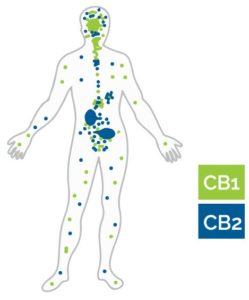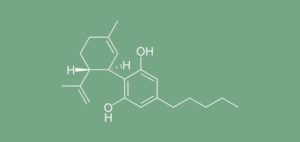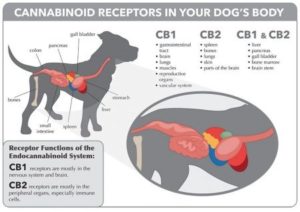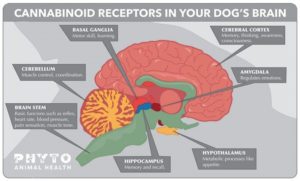CBD Science
The Science of CBD
Endocannabinoid System
A system of specialized receptors is found in the brain and peripheral nervous system throughout the body of all vertebrates and mammals. It is found in primitive animals 600 million years ago and every animal except insects. Recent research indicates that the Endocannabinoid System (ES) appears to play a “protective” role in our bodies. In fact, the most important thing the ES wants to protect is homeostasis – that is, making sure that the body is functioning optimally at all times. There was not much known about the disease implications of the ES and for several years the ES was overlooked as a possible therapeutic target. Due to the success stories of the medicinal use of cannabis and hemp products, the ES is now being discussed during the medical training of US physicians.

In the late 1980’s scientist discovered these cannabinoid receptors and named them CB1, which was most abundant in the brain a
nd central nervous system and CB2, as opposed to CB1, was found mostly in the peripheral cells, especially in the immune system. CB1 receptors are also found in the lungs, blood vessels, muscles, digestive tract, and reproductive organs. The stimulation of CB1 receptors has psychoactive and behavioral effects. CB2 receptors are primarily found in the liver, bone marrow, pancreas, and brain stem. CB2 receptors are involved in the modulation of a number of biological functions, including inflammation and pain response.
Humans naturally produce endogenous cannabinoids (endocannabinoids) to bind to these receptors called anandamide and 2-archidonoylglyverol (2-AG). These endocannabinoids are released from the nerve cells to back regulate the nerve activating neurotransmitter. Thus, endocannabinoids modulate every other neurotransmitter in an effort to maintain the body’s homeostasis (balance).
The plant chemicals found in cannabis (phytocannabinoids) closely mimics the body’s endogenous cannabinoids to bind to the same receptor system. The phytocannabinoids occur naturally within the cannabis sativa plant and include over eighty or more chemicals including omega fatty acids that interact with the cannabinoid receptors. These include the two well-known cannabinoids, Delta 9-tetrahydrocannabinol (THC) and cannabidiol (CBD). THC mimics the natural endocannabinoid, anandamide, to stimulate CB1 receptors to produce psychiatric and circulatory effects. CBD lacks the psychoactive effects of THC and appears to have many health benefits.
Endocannabinoid Deficiency Syndrome
Unfortunately, modern US diets do not always contain the nutrition required to maintain the endocannabinoid system properly. In cases where nutritional deficiencies or other problems are causing the endocannabinoid system to fail, a person may develop a condition known as “Endocannabinoid Deficiency Syndrome”. This can lead to a variety of symptoms and related conditions, including irritable bowel syndrome, fibromyalgia, migraines and more.
If your diet doesn’t contain a sufficient amount of Omega-3 fatty acids, your body may be unable to produce the proper amount of endogenous cannabinoids on its own. In addition, because Omega-3 fatty acids grow and repair your CB1 receptors, the cannabinoids your body does produce may not affect the endocannabinoid system as strongly as they should.
CBD 
Cannabidiol (CBD) is another abundant cannabis phytocannabinoid (plant-based chemical naturally found in cannabis) that appears to be helpful for many health conditions, including epilepsy, anxiety, chronic pain, and more with few side effects. Roger Adams, Madison Hunt and J.H. Clark, chemists at the University of Illinois’ Noyes Chemical Laboratory in 1940, were the first to isolate CBD. Utilizing ethanol extraction and distillation of the flower tops of hemp, they were able to further theorize that there would be many structurally related compounds to CBN and CBD present in cannabis. This turned out to be true as many other compounds, including THC, were later extracted and characterized from the cannabis plant. Prior to their experiments, cannabinol (CBN) was the only cannabinoid which had been characterized from the cannabis plant. The scientists characterized CBN from samples of hashish sourced from India, and this was the compound they were looking for in wild hemp grown in Minnesota.
Unlike THC, CBD does not cause a high. It is non-psychoactive because it does not act on the same receptors as THC. CBD seems to naturally counteract the marijuana high. Numerous studies suggest that CBD acts to reduce the intoxicating effects of THC, such as memory impairment and paranoia.
According to a 2013 review published in the British Journal of Clinical Pharmacology, studies have found CBD to possess the following medical properties:
|
Medical Properties of CBD |
Effects |
|
Antiemetic |
Reduces nausea and vomiting |
|
Anticonvulsant |
Suppresses seizure activity |
|
Antipsychotic |
Combats psychosis disorders |
|
Anti-inflammatory |
Combats inflammatory disorders |
|
Anti-oxidant |
Combats neurodegenerative disorders |
|
Anti-tumoral/Anti-cancer |
Combats tumor and cancer cells |
|
Anxiolytic/Anti-depressant |
Combats anxiety and depression disorders |
|
Analgesic |
Combats pain and pain-related disorders |
CBD has been shown to have an inhibitory effect on the inactivation of endocannabinoids, thereby enhancing the action of these endogenous molecules on cannabinoid receptors, which is also noted in certain pathological conditions. CBD acts not only through the endocannabinoid system, but also causes direct or indirect activation of certain metabotropic receptors.
The pharmacological action of CBD is very interesting, as it has very little action at the CB1 and CB2 receptors. However, it is able to block the actions of compounds which activate these receptors, such as THC. This property of CBD is important as it can suppress that psychoactivity of THC, which can be useful for those who are using THC for treating conditions such as pain and spasticity. Reducing the psychoactivity would reduce the ‘side effects’ of THC and medicinal cannabis, and this balance can be controlled by administering CBD with THC.
Unfortunately, most of this evidence comes from animals, since relatively few studies on CBD have been carried out in human patients.
Br J Clin Pharmacol. 2013 Feb;75(2):323-33. doi: 10.1111/j.1365-2125.2012.04341.
THC 
Delta 9-tetracannabinol (THC) is a phytocannabinoid (plant-based chemical naturally found in cannabis) that is better known for its psychoactive effects. Dr. Ralph Mechoulam discovered THC in 1964 when he identified it as the chemical in marijuana that was responsible for making people feel high. The “high” associated with high doses of marijuana leads to altered perception of time and space, and feelings of happiness or fatigue. In low doses, the compound causes some pain reduction, may reduce aggression, can stimulate appetite, and may help reduce nausea.
The actions of THC result from its partial agonist activity at the cannabinoid receptor CB1, located mainly in the central nervous system, and the CB2 receptor, mainly expressed in cells of the immune system. The psychoactive effects of THC are primarily mediated by the activation of the cannabinoid receptors, which result in a decrease in the concentration of the second messenger molecule cAMP through inhibition of adenylate cyclase.
THC is found in its acid form (THCA) in raw cannabis. Heat and light decarboxylates THCA into the fat-soluble THC. Although THCA does not bind to CB1 and CB2 receptors, nor cross the blood-brain barrier it has been found to have beneficial effects on the gonads (on the ovaries in women and the testicles in men).
THC has potentially anti-cancer, anti-anxiety, anti-hypertensive, anti-nausea, anti-spasmodic, and glucose lowering effects (THC increases glucose uptake in muscles independent of insulin). THC also helps increase the endogenous anandamide levels.
In several studies on mice, it has been found to reduce tumor growth, and a 2006 study also suggests that it might reduce plaque formation in the brain and either delay the onset or reduce the severity of Alzheimer’s disease. Additional studies indicate that THC could reduce painful spasms in people with multiple sclerosis and may help control the symptoms of Parkinson’s disease.
THC is an illegal drug in most countries which imposes restrictions on research material supply and funding. Although THC is mildly addictive, it can be modulated with the use of CBD. It is one of only three cannabinoids scheduled by the UN Convention on Psychotropic Substances (the other two are dimethylheptytpran and parahexyl). It was listed under Schedule I in 1971, but reclassified to Schedule II in 1991 following a recommendation from the World Health Organization (WHO). Based on subsequent studies, the WHO has recommended the reclassification to the less-stringent Schedule III. Cannabis as a plant is scheduled by the Single Convention on Narcotic Drugs (Schedule I and IV). It is specifically still listed under Schedule I by US federal law under the Controlled Substance Act passed by the US Congress in 1970.
Hemp
A cannabis plant that contains naturally contains naturally higher levels of CBD and less THC is used for industrial purposes and more recently, its medicinal qualities. Hemp has been noted to have over 30,000 different industrial and medicinal uses. Due to selective breeding, cannabis growers have been able to create plant strains with high levels of CBD and with little to no THC and as a result can be grown legally in many countries around the world.
Hemp is healthy, pure, and nutrient dense making it a nearly perfect food source. It is high in digestible protein, healthy omega essential fatty acids and naturally occurring minerals. Hemp is free of gluten and has no known allergens. Hemp seeds have a balanced 1:3 ratio of naturally occurring Omega-1 and Omega-6 essential fatty acids. Unlike other seeds and nutritional oils such as flax and fish oils, hemp seeds contain the powerful Stearidonic Acid and Gamma Linolenic Acid known as “Super Omegas”.
Hemp provides an environmentally sustainable solution for potentially thousands of products, including building materials, car parts, plastics, paper, textiles, and ethanol. Hemp is a low-impact agricultural product and a renewable resource.
Hemp oil can be produced from the seeds and most effectiously from the whole plant flowers and leaves. The flowers contain the “microfactories” called trichomes that produce the majority of the cannabinoids and terpenes in the cannabis plant. The trichomes are more densely located on the flowers of the cannabis plant. The hemp seeds produce very little to no cannabinoids.
Marijuana
Most recognized name for the cannabis plant negatively attributed to Mexicans who smoked the cannabis plant in the 1940s. Marijuana is primarily associated with the psychiatric effects of THC. Marijuana although more attributed to THC, consists of both the cannabis plant strain varieties of indica and sativa. Marijuana also contains CBD and other terpenes, usually at significantly lower levels, which may account for its medicinal effects.
Entourage Effect
The “entourage effect,” results when hundreds of natural components within a plant interact together and with the human body to produce a stronger influence than any one of those components used alone. It’s a synergistic effect. When we combine multiple compounds in their natural state, we don’t end up with the sum of the parts, but rather we get a multiplying effect instead. The different compounds can amplify each other’s effects, making the overall plant more effective in treating the unwanted medical symptoms (1).
The entourage effect becomes especially evident when comparing the effects of tetrahydrocannabinol (THC), the psychoactive component of the cannabis plant (marijuana), with the effects of using the whole plant. When pure, synthetic THC became available as the drug Marinol in the mid-1980s, scientists expected it to work just as well as using the entire cannabis plant. However, they quickly learned that patients preferred to use the whole plant rather than take Marinol (2).
As it turns out, cannabis contains many more active compounds than just THC. A number of cannabinoids have been found to work in conjunction with THC to produce the overall effect of symptom relief. Cannabidiol (CBD), in particular, modulates the effect of THC on the human body. Studies indicate that the ratio of THC to CBD plays a key role in determining the efficacy of the cannabis plant for therapeutic applications.
- (1) Rasoanaivo, P., Wright C.W., Willcox, M.L., and Gilbert, B. (2011). Whole plant extracts versus single compounds for the treatment of malaria: synergy and positive interactions. Retrieved from http://www.ncbi.nlm.nih.gov/pmc/articles/PMC3059462/.
- (2) Gupta, S. (2014). Medical marijuana and ‘the entourage effect.’ Retrieved from http://www.cnn.com/2014/03/11/health/gupta-marijuana-entourage/.
CBD and Drug Interactions
Cannabidiol (CBD) can inhibit the cytochrome P-450 system’s ability to metabolize certain drugs, the cytochrome P-450 enzyme system is a system that contains over 50 enzymes that process and eliminate toxins within the liver that is responsible for metabolizing 90 percent of the drugs you consume. If it is compromised, it can lead to an overall increase in the drug processing times. This leads to higher levels of the drug in your system at one time, which can cause unwanted side effects and even overdose. Thus, if you are taking a drug affected by cannabidiol, you may need a dosage adjustment in order to take both drugs safely.
Any drug metabolized by cytochrome P-450 enzymes could potentially interact with cannabidiol. Drugs known to use the cytochrome P-450 system include:
- Steroids
- HMG CoA reductase inhibitors
- Calcium channel blockers
- Antihistamines
- Prokinetics
- HIV antivirals
- Immune modulators
- Benzodiazepines
- Anti-arrhythmics
- Antibiotics
- Anesthetics
- Anti-psychotics
- Anti-depressants
- Anti-epileptics
- Beta blockers
- PPIs
- NSAIDs
- Angiotension II blockers
- Oral hypoglycemic agents
- Sulfonylureas
Keep in mind that this list does not necessarily contain every medication that could be affected by cannabidiol. Likewise, not every medication in each of the categories listed will cause an interaction. For this reason, you should consult with a medical professional before taking any combination of drugs at the same time, as alternative medications or dosage adjustments may be required.
CBD and Animals
Cannabis can be used for animals. The endocannabinoid system was discovered in primitive animals from over 600 million years ago and in all mammals, birds, fish and reptiles today.


The animal endocannabinoid system works and acts the same as it does in humans. Thus, the same phytocannabinoids will act and have the same effect as it would in humans as animals but much more dose related.
Recent cannabinoid research has shown that cannabinoids have had beneficial efficacy in many conditions for both humans and pets:
Anxiety
Anxiety in pets can be disruptive as well as debilitating. Areas of the brain rich in CB1 receptors are known to be involved in mood stress and fear. CB1 receptors are known to mediate fearfulness and anxiety. Mice bred with no CB1 receptors are mice that have their CB1 receptors blocked showed constant fear anxiety. In contrast, cannabinoids boost CB1 receptors and produce a calming effect. Recent studies show that CBD exerts and inherent anxiolytic effects both in rodent models and humans. It also has been shown to reduce social phobia and anti-panic effects.
Aging
Pets as well as humans suffer mental decline with aging. Cognitive Dysfunction Syndrome in animals correlates to human Alzheimer’s disease. People with Alzheimer’s exhibits drastically reduced functioning of the cannabinoid receptors in the brain and have increased plaque deposits and microglia, which causes inflammation. Multiple cannabinoids exhibit neuroprotective, anti-inflammatory and antioxidant properties that maybe important in protecting nerve cells. Studies in rat plaque models injected with cannabinoids showed improved tests of mental ability and their brains had reduced microglia and inflammation. New studies show that CBD helps regenerate new neurons in the part of the brain responsible for memory. Animals with memory loss were given CBD and experienced memory improvement.
Arthritis
Pets suffer from both osteoarthritis (associated with aging) and rheumatoid arthritis (associated with autoimmune disease). In both types of arthritis, CBD reduces inflammation and pain to decrease symptoms. CBD acts as both an immunosuppressant and anti-inflammatory factor to protect the joints against severe damage and to inhibit the release of tumor necrosis factor that causes joint inflammation and destruction. Other cannabinoids also may show anti-inflammatory properties.
Inflammation
Dogs and other pets can suffer from a variety of inflammatory diseases. Inflammation is now recognized as the underlying basis of many diseases. CB2 receptors appear to be critical targets for regulating inflammation, and cannabinoids have been shown to be effective in suppressing inflammation all over the body. Cannabinoids suppress inflammatory responses, and thus lessen disease symptoms.
CBD Legality
Even though CBD shows much promise as a medicine, it remains illegal in many parts of the world. CBD is classified as a Schedule I drug in the United States and a Schedule II Drug in Canada.
In 2014, Kentucky, Vermont and Colorado grew hemp pilot crops under section 7606 of the 2014 Farm Bill. A hemp amendment to the 2014 Congressional Omnibus Appropriations Bill prohibits DEA and DOJ from spending tax dollars to deter hemp farming for research in states where it is legal.
CBD products may also be sold in certain states that have legalized medical and/or recreational marijuana.






